VISUAL ARTS
PAPER – III
Note : This paper contains seventy five (75) objective type questions of two (2) marks each. All questions are compulsory.
1. The artist who is known to introduce serigraphy as a medium of art expression
(1) Lalit Mohan Sen
(2) Chitto Prasad Bhattacharya
(3) Harendra Narayan Das
(4) K.G. Subramanyam
2. The group of 12 Artists named ‘Indian Printmaker’s Guild’ was found in
(1) 1970
(2) 1980
(3) 1990
(4) 2000
3. Treadle, Planten, Cylinder and Rotary machines belongs to
(1) Letter Press
(2) Offset Press
(3) Gravure
(4) Serigraphy
4. Monotype belongs to
(1) Wood cut
(2) Metal printing
(3) Lithography Printing
(4) Serigraphy
5. Which of the following is not Graphic artist ?
(1) Rembrandt
(2) Jeannert Eduard
(3) Lipchitz Jacques
(4) Charles Jacques
6. Who made printed illustration for Rabindranath Tagore’s book ‘Sahaj Path’ ?
(1) Ramkinkar Baij
(2) Nandalal Bose
(3) Benode Behari Mukherjee
(4) Abanindranath Tagore
7. ‘The LAMASSU’ represents
(1) The Snake Goddess
(2) Mithuna
(3) Kouros
(4) Winged human headed Bull
8. From where did M.V. Dhurandhar take his art Education ?
(1) College of Art, Delhi
(2) Meyo School of Art, Lahore
(3) J.J. School of Art, Bombay
(4) S.R.S. School of Art, Jaipur
9. Who painted the series named “After the Cyclone” ?
(1) Paritosh Sen
(2) M.F. Hussain
(3) Jatin Das
(4) J. Swaminathan
10. What is used in the paintings of Basohli School to show the impression of Emerald ?
(1) Peacock Feather
(2) DanaFarang
(3) Sonkirwa
(4) Lazward
11. Paper cutouts used for decorating an object is known as
(1) Decoupage
(2) Poster
(3) Cover page
(4) Collage
12. Triptych Painting entitled “where are all the flowers gone” is painted by
(1) A. Ramachandran
(2) Bhupen Khakkar
(3) Frida Kohl
(4) Arpana Caur
13. Where is Rouza of Rani Sipani ?
(1) Gulbarga
(2) Ahmed Nagar
(3) Ahmedabad
(4) Mandu
14. Who coined the term Anti-Art ?
(1) Tristan Tzara
(2) Jean Arp
(3) Marcel Duchamp
(4) Andre Breton
15. Who is the author of the Book “Exploring India’s Sacred Arts” ?
(1) Anand Coomar Swamy
(2) Stella Kramrisch
(3) Herman Goetz
(4) A.L. Basham
16. Vaikuntha Murti is a typical expression of Vishnu popularly found from medieval
(1) Bengal
(2) Kashmir
(3) Nepal
(4) Gujarat
17. Name the earliest care whose entrance decoration is proto wooden type :
(1) Bhaja Chaitya
(2) Sudama Cave
(3) Ajanta Cave No. 16
(4) Lomash Rishi Cave
18. From the following whose paintings represent French Classicism ?
(1) Nicola Poussin
(2) Jaque David
(3) Francois Boucher
(4) Jean Antoine Watteau
19. Lothal and Kalibangan both are
(1) situated in Gujarat
(2) pre Maurian Site
(3) famous for ancient port
(4) Harappan site
20. “Harvestor” is a sculpture by
(1) Picasso
(2) Ramkinkar
(3) Pradosh Dasgupta
(4) Giacometti
21. Barbara Hepworth was a
(1) British Sculptor
(2) American Sculptor
(3) Swedish Sculptor
(4) French Sculptor
22. “Meaning is not a Quality, but a function of a term” was written by
(1) Susanne K. Langer
(2) Benedetto Croce
(3) Aristotle
(4) R.G. Collingwood
23. Burning of marble stone could be expressed through the formulation
![]()
The stone mass converts into
(1) Cement
(2) Lime
(3) Marble dust
(4) Carborundum powder
24. Henry Moor was influenced by
(1) Maya, Aztec Sculptures
(2) Etruscan Sculptures
(3) African Sculptures
(4) Indian Sculptures
25. The name of the originator’s of works used in an Advertising Design is called
(1) Headlines
(2) Credit Lines
(3) Title
(4) Subhead
26. In which city, the ‘Underground’ represents an important historic context for posters ?
(1) London
(2) Berlin
(3) New York
(4) Warsaw
27. Raster and Vector are the two main ways of saving a
(1) Photograpic image
(2) Digital image
(3) Graphic image
(4) Printed image
28. To print photographic tones, the image is converted into a series of
(1) dots
(2) lines
(3) lines and dots
(4) pixels
29. One of the key theories that underpin the foundations of design :
(1) AIGA
(2) Gestalt Theory
(3) Theory of Relativity
(4) Hermeneutics
30. Which was the first commercial form of printing press to be used with movable type ?
(1) Offset Lithography
(2) Silk Screen Printing
(3) Letterpress printing
(4) Digital printing
31. Select correct sequence of process in print making :
(1) Grinding, Drawing, Gum application, Printing
(2) Drawing, Gum application, Printing, Grinding
(3) Grinding, Printing, Gum application, Drawing
(4) Drawing, Grinding, Printing, Gum application
32. Select the correct famous print makers in chronological order :
(1) Michael Wolgemut, William Hogarth, Rembrandt, Ottavio Leoni
(2) Rembrandt, Ottavio Leoni, Michael Wolgemut, William Hogarth
(3) Ottavio Leoni, Michael Wolgemut, Rembrandt, William Hogarth
(4) Michael Wolgemut, Ottavio Leoni, Rembrandt, William Hogarth
33. Choose the correct sequence in chronological order :
(1) Etching, Lithography, Screen Printing, Woodcut
(2) Woodcut, Etching, Lithography, Screen Printing
(3) Lithography, Etching, Screen Printing, Woodcut
(4) Woodcut, Lithography, Etching, Screen Printing
34. Arrange the following chronological order :
(1) Bhaja, Karle, Badami, Ellora
(2) Karle, Bhaja, Ellora, Badami
(3) Ellora, Karle, Badami, Bhaja
(4) Badami, Ellora, Karle, Bhaja
35. Arrange the following artists in chronological order :
(1) Picasso, Paul Klee, Kandinsky, Matisse
(2) Matisse, Picasso, Paul Klee, Kandinsky
(3) Kandinsky, Matisse, Paul Klee, Picasso
(4) Paul Klee, Kandinsky, Picasso, Matisse
36. Choose the correct chronological order of Indian texts :
(1) Kadambari, Abhinavbharti, Vrahatsanhita, Panchdashi
(2) Vrahatsanhita, Kadambari, Abhinavbharti, Panchadashi
(3) Abhinavbharti, Panchdashi, Kadambari, Vrahatsanhita
(4) Panchdashi, Kadambari, Vrahatsanhita, Abhinavbharti
37. Choose correct ascending order of the parts of pillar in Greek Architecture :
(1) Architrave, Capital, Shaft, Pedestal
(2) Capital, Architrave, Shaft, Pedestal
(3) Pedestal, Shaft, Architrave, Capital
(4) Pedestal, Shaft, Capital, Architrave
38. Choose the correct chronological order of evolution of the temples of Odisha :
(1) Konark Sun Temple, Lingraj, Mukteswara, Parasurameswara
(2) Mukteswara, Lingraj, Konark Sun Temple, Parasurameswara
(3) Lingraj, Konark Sun Temple, Parasurameswara, Mukteswara
(4) Parasurameswara, Mukteswara, Lingraj, Konark Sun Temple
39. Choose correct sequence of paintings in chronological order :
(1) Baptism of Christ, the Adoration of the Magi, The Last Supper, Mona Lisa
(2) The Adoration of the Magi, Baptism of Christ, The Last Supper, Mona Lisa
(3) Mona Lisa, The Last Supper, Baptism of Christ, the Adoration of the Magi
(4) The Last Supper, Baptism of Christ, Mona Lisa, the Adoration of the Magi
40. Arrange the Advertising Agencies in order of their establishment :
(1) Mudra Communication Ltd., OGilvy & Mather Ltd., McCann Erickson India Ltd., R.K. Swamy BBDO
(2) McCann Erickson India Ltd., OGilvy & Mather Ltd., R.K. Swamy BBDO, Mudra Communication Ltd.
(3) R.K. Swamy BBDO, McCann Erickson India Ltd., Mudra Communication Ltd., OGilvy & Mather Ltd.
(4) OGilvy & Mather Ltd., Mudra Communication Ltd., R.K. Swamy BBDO, McCann Erickson India Ltd.
41. Arrange the major steps in printing production :
(1) Creative work, Prepress, Printing, Finishing & Converting
(2) Finishing & Converting, Prepress, Printing, Creative work
(3) Prepress, Printing, Finishing & Converting, Creative Work
(4) Printing, Prepress, Creative Work, Finishing & Converting
42. Arrange the names of the creative leaders in Indian Advertising in order of appearing :
(1) Piyush Pandey, Prasoon Joshi, Prasoon Pandey, Alyque Padamsee
(2) Alyque Padamsee, Piyush Pandey, Prasoon Pandey, Prasoon Joshi
(3) Prasoon Pandey, Prasoon Joshi, Alyque Padamsee, Piyush Pandey
(4) Prasoon Joshi, Piyush Pandey, Alyque Padamsee, Prasoon Pandey
43. Select the correct sequence in chronological order :
(1) Greek Art, Roman Art, Egyptian Art, Baroque Art
(2) Egyptian Art, Greek Art, Roman Art, Baroque Art
(3) Roman Art, Greek Art, Egyptian Art, Baroque Art
(4) Greek Art, Egyptian Art, Roman Art, Baroque Art
44. Select the correct sequence of sculptures in chronological order :
(1) Baboon and Young, The Age of Bronze, Monument to the Third International, The King Playing with the Queen.
(2) The Age of Bronze, Baboon and Young, Monument to the Third International, The King Playing with the Queen
(3) Monument to the Third International, The Age of Bronze, Baboon and Young, The King playing with the Queen,.
(4) The Age of Bronze, Monument to the Third International, The King playing with the Queen, Baboon and Young
45. Select the correct sequence in chronological order :
(1) D.P. Roy Chowdhury, Chintamoni Kar, Latika Katt, Nagji Patel
(2) D.P. Roy Chowdhury, Nagji Patel, Chintamoni Kar, Latika Katt
(3) D.P. Roy Chowdhury, Latika Katt, Chintamoni Kar, Nagji Patel
(4) D.P. Roy Chowdhury, Chaintamoni Kar, Nagji Patel, Latika Katt
46. Match the following :
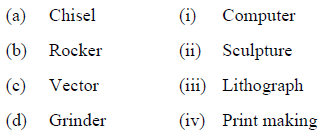
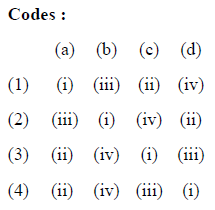
47. Match the following :


48. Match the following :

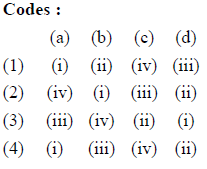
49. Match the following :


50. Match the following :


51. Match the following :


52. Match the following :


53. Match the following :


54. Match the followings pairs :


55. Match the following :


56. Match the following :

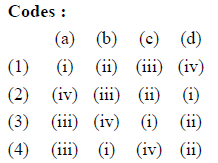
57. Match the following :


58. Match the following :


59. Match the following :

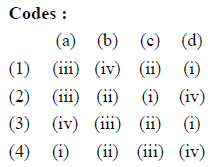
60. Match the following :

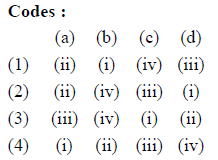
61. Assertion (A) : Screen printing process can be used for printing on any 2D and 3D surface.
Reason (R) : Because the essential tools used for printing in all print making processes are same.
(1) (A) and (R) both are correct.
(2) (A) is correct, but (R) is incorrect.
(3) (A) is incorrect, but (R) is correct.
(4) (A) and (R) both are incorrect.
62. Assertion (A) : ‘A la poupée’ is an intaglio print making technique for using different colours of ink.
Reason (R) : Because the term a la poupée means ‘with a doll’, which refers to the wad of fabric.
(1) (A) and (R) both are correct.
(2) (A) is correct, but (R) is incorrect.
(3) (A) is incorrect, but (R) is correct.
(4) (A) and (R) both are incorrect.
63. Assertion (A) : Print making is a process of obtaining printed image by using a surface.
Reason (R) : Because from the beginning of 17th century, lithographic stone were used and paved the way for etching process.
(1) (A) and (R) both are correct.
(2) (A) is correct, but (R) is incorrect.
(3) (A) is incorrect, but (R) is correct.
(4) (A) and (R) both are incorrect.
64. Assertion (A) : Raja Ravi Varma gave an Indian identity and acceptance to western oil painting technique.
Reason (R) : He recognised the Indian values and cultural traditions and gave a new vision to Indian art.
Codes :
(1) Both (A) & (R) are incorrect.
(2) (A) is correct & (R) is incorrect.
(3) Both (A) & (R) are correct.
(4) (A) is incorrect & (R) is correct.
65. Assertion (A) : There is no art tradition similar to the tradition of Ragamala painting in the world.
Reason (R) : Because Abstract subject like music has been given a form in Ragamala paintings.
Codes :
(1) Both (A) & (R) is correct.
(2) (A) is correct & (R) is incorrect.
(3) (A) is incorrect & (R) is correct.
(4) Both (A) & (R) are incorrect.
66. Assertion (A) : Drawing is basic component of the visual arts.
Reason (R) : Because without it form and image cannot be created.
Codes :
(1) Both (A) and (R) correct.
(2) (A) is correct and (R) is incorrect.
(3) (A) is incorrect and (R) is correct.
(4) Both (A) and (R) incorrect.
67. Assertion (A) : Bernini employed every sort of illusionism imaginable in his carvings.
Reason (R) : He wanted to transform his figures of hard and cold marble into warm flesh and airy effect in fleeting moment.
Codes :
(1) (A) and (R) both are correct.
(2) (A) and (R) both are not correct.
(3) (A) is correct, but (R) is not correct.
(4) (A) is not correct, but (R) is correct.
68. Assertion (A) : Andy Warhol is undisputed fine art master of mass media manipulation.
Reason (R) : Because he used images of popular celebrities of his time in his art.
Codes :
(1) (A) is correct but (R) is not correct.
(2) (A) is not correct, (R) is correct.
(3) (A) and (R) both are not correct.
(4) (A) and (R) both are correct.
69. Assertion (A) : Cognition is the intellectual process by which knowledge is gained about perception and ideas.
Reason (R) : Cognition is dynamics of knowing.
Codes :
(1) (A) is correct but (R) is not correct.
(2) (A) is correct and (R) is near to correct.
(3) (A) is not correct, but (R) is correct.
(4) (A) is not correct and (R) is also not correct.
70. Assertion (A) : Many awards and honours were bestowed on sculptor Sri Ram V. Sutar in recognition of his phenomenal achievements.
Reason (R) : Ram has mastery over stone and marble sculpting, but he delights in casting bronze and many of his most famous works are in bronze.
Codes :
(1) (A) is incorrect and (R) is correct.
(2) (A) and (R) both are correct.
(3) (A) and (R) both are incorrect.
(4) (A) is correct and (R) is incorrect.
71. Assertion (A) : “Monument to Balzac” is a sculpture by Auguste Rodin in memory of the French novelist Balzac. According to Rodin, the sculpture aims to portray the writer’s personality rather than a physical likeness.
Reason (R) : After coming under criticism the model was accepted by the society. The Model was cast in bronze and immediately placed on the “Boulevard du Montparnasse”.
Codes :
(1) (A) is incorrect and (R) is incorrect.
(2) (A) and (R) both are correct.
(3) (A) is incorrect and (R) is correct.
(4) (A) and (R) both are incorrect.
72. Assertion (A) : Nandagopal’s signature style is a blend of traditional and Contemporary Art.
Reason (R) : Nandagopal’s sculptures often have a frontal aspect which is one of the defining characteristics of Madras Art movement.
Codes :
(1) (A) and (R) both are correct.
(2) (A) and (R) both are incorrect.
(3) (A) is correct (R) is incorrect.
(4) (A) is incorrect (R) is correct.
73. Assertion (A) : Many of the world’s top famous logos use animals.
Reason (R) : Animal imageries are very effective method of describing core attributes of a product or a company.
In the context of two statements, which one of the following is correct ?
Codes :
(1) (A) is true but (R) is false.
(2) Both (A) and (R) are true.
(3) Both (A) and (R) are false.
(4) (A) is false, but (R) is true.
74. Assertion (A) : The use of images with text is at the heart of the definition of graphic design.
Reason (R) : This combination decreases graphic possibilities by many times of magnitude.
Codes :
(1) (A) is true, (R) is also true.
(2) (A) is true, but (R) is false.
(3) Both (A) and (R) are false.
(4) Both (A) and (R) are true, but (R) is not the correct explanation of (A).
75. Assertion (A) : Most of the curriculum in design schools is concerned with how to make things look good.
Reason (R) : Critical role of the graphic designers professionally play in the delivery of information with accuracy, not the look.
In the context of two statements, which one of the following is correct ?
Codes :
(1) (A) is true, but (R) is false.
(2) (A) is false, but (R) is true.
(3) Both (A) and (R) are correct.
(4) Both (A) and (R) are false.
Latest Govt Job & Exam Updates: